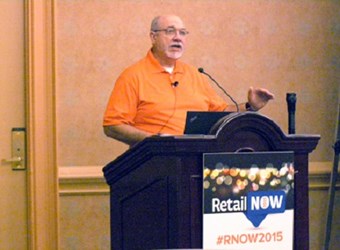ScanSource's Dixon Gives Advice On Surviving As A Retail IT VAR


As retail IT changes — with innovations in mobile point of sale (POS), payment types, and data analytics — the way a VAR creates and delivers solutions to their clients is also undergoing changes.
Greg Dixon, CTO of ScanSource, illustrated how VARs will — and must — transition from the traditional way of doing business to a new business model in his presentation “Retail IT in TransITion: The Survivor’s Way Forward.” Dixon presented the topic at an education session at Retail Solutions Providers (RSPA) RetailNOW 2015, Aug. 4, at the Gaylord Palms Resort and Conference Center in Orlando, FL.
Dixon said the changing retail IT landscape is necessitating changes related to all components of IT solutions: software, hardware, and services. Changes in the way you sell software are linked to its move to the cloud and the SaaS model. With SaaS, the client will transition from having a capital expenditure to an operational expense — and you will transition from a one-time accounts receivable invoice to a monthly invoice and monthly recurring revenue (MRR).
As for hardware, Dixon said, “Of course, it goes to the cloud as well. The software is there. The hardware has to follow.” He explained with a hosted server, the server that used to be on the premises is now in the cloud, and Infrastructure-as-a-Service is sold on a usage basis — another potential source of MRR. He urged VARs also to consider offering new services that you hadn’t before, such as backup and disaster recovery, email, spam filters — solutions your clients turned to other providers for in the past.
He said transitions related to hardware could involve the move from fixed to mobile POS, and perhaps, offering Hardware-as-a-Service (HaaS). Dixon also commented VARs would benefit from providing all of the client’s IT: “The last thing I want to do is have the mobile device that I’ve given them plug into someone else’s wireless network.” This also opens up the possibility of providing network security solutions and helping your merchant IT clients achieve Payment Card Industry Data Security Standard (PCI DSS) compliance. This transition, said Dixon, is the evolution from providing partial solutions to complete solutions. “That’s big. I want you to stop thinking of yourself as a POS VAR, and start to thinking of yourself as a reseller of retail IT. That’s critical,” he stressed.
Dixon said providing services, too, will change. He said, traditionally, services made up 20 percent of a sale, with hardware and software splitting the other 80 percent. With a transition to the recurring revenue business model, services will increase to about 40 percent of a sale, which Dixon points out makes up for losses elsewhere. You can accomplish this with the addition of managed services: monitoring and maintaining your customers’ devices, POS terminals, mobile devices, routers and switches, wireless network — and even PCI compliance and infrastructure. He said managed services providers (MSPs) need two tools to accomplish this: professional services automation (PSA) and remote monitoring and management (RMM). The PSA allows you to manage the business of your managed services practice and analyze your profitability as well as helping with billing and project management. RMM communicates the details about particular devices, automatically sending alerts if there is a problem — often even before the customer knows there is a problem. It also enables you to correct some issues without sending a technician to the location.
Dixon said, for many IT departments in other markets, managed services has been around for years. “Managed services is a mature business model for corporate IT departments. But for retail, it’s new. You’re the one that gets to introduce it to them,” he commented.
He also explained that making this transition changes your service offerings from reactive to proactive. “Proactive means I’m on top of this thing. I’m watching it all the time. The network and the devices themselves are now talking back to me, the MSP,” Dixon explained. He added that it’s important to report back to your merchant IT client each quarter to let them know what you did and how it prevented downtime. He said with this transition in your business, your goals align with your customer’s goals: “When the equipment is working the best, that’s when I make the most money. That buys that kind of loyalty that you can’t get otherwise.”
Dixon urged VARs also to consider how else they can provide IT needs for customers — not just batteries and cables but also video surveillance solutions, communications systems, and location analytics. “That’s the rest of retail IT that we’ve been losing all these years,” he said.
“That’s where you’re going to need to be. Rethink your whole business model. You’re going to transition from every month at zero to a healthy financial model,” Dixon said. “This may seem a little radical, but I really believe it’s a sustainable business model.”
“It’s the survivor’s way forward. I really believe this,” he said.
During RetailNOW, ScanSource launched its As-A-Service Suite, a program designed to help resellers offer multiple service-oriented solution option.
For more articles on RetailNOW 2015, held August 2-5 at the Gaylord Palms Resort and Convention Center in Orlando, and the Retail Solutions Providers Association (RSPA), go to www.BSMinfo.com/go/InsideRSPA.
